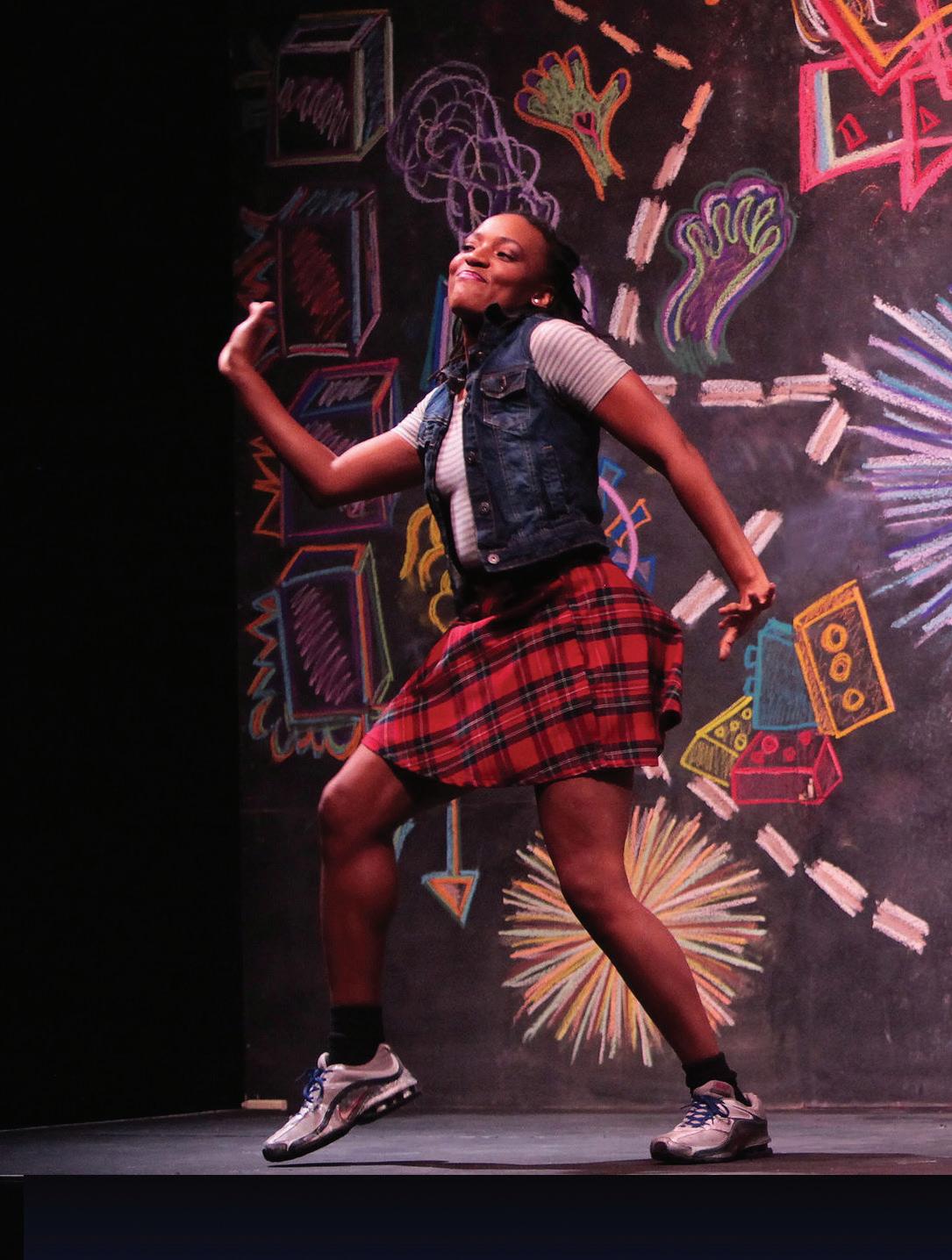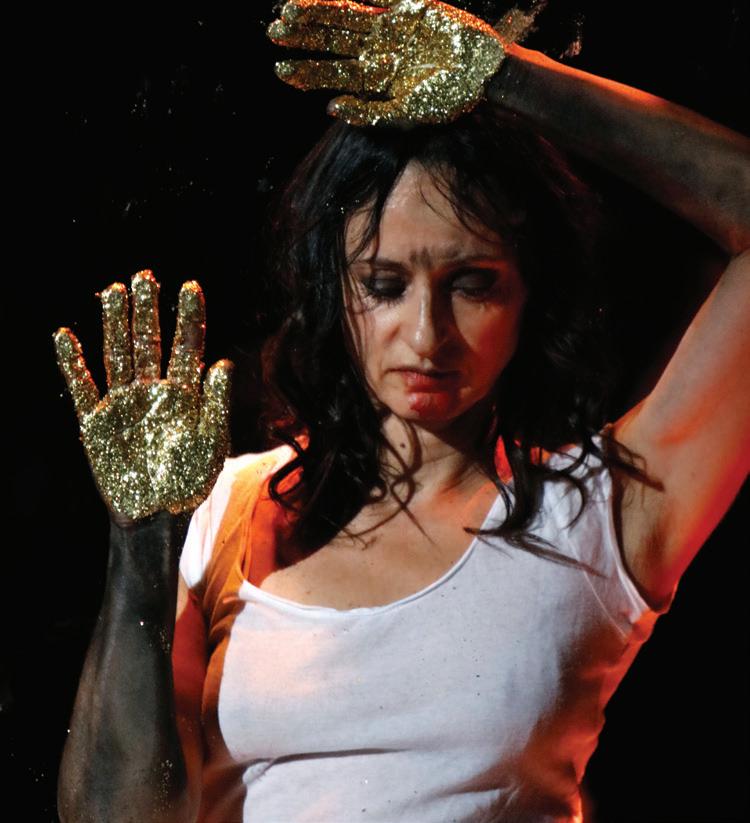
7 minute read
A Knowing Place
“M Stabat Mater.” Photo: Eyal Landesman.
A KNOWING PLACE I. BY JESSICA LYNNE
Stood The Mother Grieving. Stood The Mother Grieving As Her Only Son Was Slain. Stood The Mother Grieving As His Body Was Pulled From The Tallahatchie River. Stood The Mother Grieving As She Prepared His Body For Funeral Services.
The Mother stood grieving as she dared us to look upon his mutilated face. And in her grief, there was profound rage and tenderness and foresight. The Mother wanted the world to see what it had done to her baby.
How fascinating to know that grief and strength might be two sides of the same coin. That in a moment of terrible sorrow — when your body moves slowly, limbs outstretched grasping for solace, when heartache pierces, when you collapse to the floor in silence, back arched, a wail sitting on your lips — that there might also exist the fervent resolution to persevere.
Did the Mother know, as she stood grieving, that she would awaken a new season? As Demeter retrieved Persephone, bringing with her new fruit, so too did the Mother’s retrieval of her son’s body usher forth a call for justice, galvanizing a people.
In Inbal Oshman’s “M Stabat Mater,” there is a moment when the four dancers take a knee at the front of the stage. Their left forearms rest on their left knees. Their right arms rise into fists behind their heads. They have come to this pause after feverish movement in which they circle in place continuously, their arms over their heads. The pace slows gradually until one dancer rolls up the cloth covering her legs. The others follow suit. They walk to the edge of the stage and kneel.
I want to linger on this moment of clarity, this attempt to reject elements of pathos. I want to know what carries a person to calm from fury and what must be done as one slips between the two states. The dancers soon collapse to the floor. Slowly they begin to cover their arms and legs in a red liquid that signifies blood. How did the Mother traverse this chasm?
Oshman is preoccupied with the vastness of motherhood. She could not know that, despite the breadth of her performance, I remain stuck in a single moment far beyond the choreographer’s immediate artistic concerns — yet intimately connected to the story she tells.
What is it to recognize a thing even if you have not yet taken part in the thing? What I mean is this:
Black motherhood is as joyous as it is precarious in this nation. I know this because I have paid attention to our records. I have watched history show itself again and again. I have watched black mothers shout in rage and march forward as the goddess Kali, prepared to fight the demons of this land, only to return home in defeat.
Surely the Mother saw something that I cannot yet see, something that I cannot yet know. That we must rinse the blood from our bodies and begin anew, even if we still carry the grief.
On Aug. 28, 1955, Emmett Till was lynched by two white supremacists in Money, Miss. His mother, Mamie Till-Mobley, held an open casket funeral to make visible the violence enacted upon her young son. Till’s murder is widely regarded as an early catalyst for the civil rights movement as it exposed, on a national scale, the brutality of the Jim Crow South. “A Knowing Place, Part I” is written in honor of Mrs. Till-Mobley — educator, activist and mother.
II. On my block there is a group of young girls who have mastered the art of double dutch. I see them often, especially when the weather is warm, this tightknit cadre of movers. Their choreography is precise, dynamic. Two command the rope, a sway in their hips as it turns. Two others jump in — knees rising and falling, facing each other.
Pit pat, pit pat, pit pat, clap! Pit pat, pit pat, pit pat, clap! Pit pat, pit pat, pit pat, turn!
The jumpers now face outward, their backs not quite touching. The two rope-turners bend slightly at the waist, and an intensity flares in their eyes. Their small wrists flick furiously. One, two. One, two. One, two. One, two. One jumper has lost a barrette from her hair. I watch her dart a glance to the sidewalk to notice where the accessory has landed before she grins widely, as if she pities the barrette because it could not keep her pace.
Pit, pat, pit pat, pit pat, twirl! Pit, pat, pit pat, pit pat, twirl!
And so goes this familiar ceremony I encounter on my evening walks home from work. How is it possible to know a thing even if we are oceans, and continents, and generations removed from the thing? What I mean is this: I am marveling at how these young girls sculpt movement from blood memory.
Choreographer Camille A. Brown is meditating on black rituals of movement. What are the stories that live in our bodies? she asks. What is known and unknown? That is, what corporeal data can be mined through dance? Brown’s “ink” reckons with the point at which inherited information meets its contemporary manifestations. She catalogs a repository of African diasporic gestures, even as she re-imagines them so that we won’t forget the many narratives they contain. Consider what Lucille Clifton offers in her poem “i am accused of tending to the past”:
i am accused of tending to the past as if i made it as if i sculpted it with my own hands. i did not. this past was waiting for me when i came, a monstrous unnamed baby and i with my mother’s itch took it to breast and named it History. she is more human now, learning languages everyday, remembering faces, names and dates. when she is strong enough to travel on her own, beware, she will.
So too does Brown cradle history, so that we might learn to recognize the unseen.
I watch a rehearsal video in which she traverses the dance floor with short, heavy, staccato steps — her knees never rising too high, her arms bent at the elbows, her waist bending toward the floor. These gestures give way to rapid jumping before coming to a cool stop. I know these movements.
On hot summer days, I watch the double dutch queens form these same gestures. The rope-turners bend at the waist; the jumpers step with force and declaration. History has traveled to them. It has found a new dialect.
TO LEARN MORE ABOUT CAMILLE A. BROWN’S “INK” TURN TO PAGE 44.

Beatrice Capote in Camille A. Brown’s “Black Girl: Linguistic Play.” Photo: Steve Gunther
“Theater, performance, installation? Like Romeo Castellucci, Angélica Liddell’s productions offer a series of more or less clear paintings that weave a book of images, often holy, that recount the wound of the world.”—LE TEMPS (France)
AMERICAN PREMIERE
ANGÉLICA LIDDELL ATRA BILIS TEATRO(SPAIN)
Photo: Isabelle Meister

It’s hard to imagine two artists, two women, more dissimilar than the poet Emily Dickinson and the Spanish performance dynamo Angélica Liddell. Dickinson spent much of her life secluded in a room in her father’s house in Amherst, Mass. Liddell has toured the world to great acclaim with her ferocious work, which she calls “pornography of the soul.” With “Esta Breve Tragedia de la Carne (This Brief Tragedy of the Flesh),” Liddell throws her sometimes naked body into a deep dive for the soul of Emily Dickinson. She uses Dickinson’s repeated use of the word “bees” and her self-imposed confinement, represented by a solitary chair, as the springboards for her imaginative interpretation of the poet’s tumultuous inner life. And Liddell doesn’t just hint at bees; enclosed in a glass box, she joins hundreds of them onstage. Liddell’s work often connects personal and physical pain with politics. If you always wanted to know what made Dickinson tick and you have a taste for fearless, world-class artistry from a brave theater maker, you need to see “Esta Breve Tragedia de la Carne.”
TEXT, SCENERY, COSTUMES, AND DIRECTION Angélica Liddell CHAIR SCULPTURE Enrique Marty MASK specialfx-alienalone.com LIGHTING Carlos Marquerie SOUND Antonio Navarro PRODUCTION MANAGEMENT Gumersindo Puche EXECUTIVE PRODUCTION laquinandi, S.L. PERFORMERS
Angélica Liddell Fabian Augusto Sindo Puche Javier Carcedo Lobeto Sandra Garcia Coronas Javier Palacios Alonso Llara Mendendez Valle Ruben Martin Rodriguez Patrice Le Rouzic Sylvestre Dechosal
Dates Thursday, April 19 @ 7:30 p.m. Friday, April 20 @ 7:30 p.m. Saturday, April 21 @ 8 p.m. Sunday, April 22 @ 3 p.m.
In Spanish with English supertitles. 50 minutes, no intermission.
—FINANCIAL TIMES
Co-produced by La Bâtie-Festival de Genève and LABoral –Centro de arte y de creación industrial. Supported by Ministerio de Educación, Cultura y Deporte –INAEM.



